Home >Java >javaTutorial >Cargo tracking and transportation visualization capabilities of Java warehouse management system
Cargo tracking and transportation visualization capabilities of Java warehouse management system
- 王林Original
- 2023-09-24 12:13:021210browse

Title: Cargo tracking and transportation visualization functions of Java warehouse management system
Abstract: With the development of the logistics industry and the increasing demand for warehouse management, warehouse management systems Become an important tool for daily operations of the enterprise. This article will introduce a Java-based warehouse management system that has functions such as cargo tracking and transportation visualization, and provide specific code examples.
- Introduction
In the modern business environment, effective warehouse management is crucial to the operation of the enterprise. Warehouse management systems allow businesses to track and manage their inventory of goods, improving cargo scheduling and logistics efficiency. In order to better meet the needs of enterprises, we have developed a Java-based warehouse management system with cargo tracking and transportation visualization functions.
- Design and architecture of Java warehouse management system
Our warehouse management system adopts object-oriented design ideas and includes the following main modules:
2.1 Cargo Information Management Module
This module is responsible for recording and managing the detailed information of the goods, including the name, quantity, production date, shelf life, etc. of the goods. Each shipment has a unique identifier in the system to facilitate subsequent tracking and inquiry.
2.2 Cargo tracking module
This module tracks the location and status of goods in the warehouse by recording the transportation information of goods. Whenever goods are moved or other operations occur, the system updates the corresponding shipping information. Users can query the historical transportation records of specific goods through the system interface to track the entire process of the goods.
2.3 Warehousing capacity management module
This module is responsible for monitoring the idle capacity and usage of the warehouse. When the warehouse capacity approaches the limit, the system will automatically issue a prompt to remind the user to adjust the warehouse layout or increase storage space.
2.4 Transportation visualization module
This module displays the transportation path and location of goods through a graphical interface. Users can see the layout of the warehouse and the distribution of goods on the system interface, allowing for better cargo scheduling and logistics planning.
- Code Example
The following is a simple code example to demonstrate the implementation of the cargo tracking function:
public class Goods {
private int id;
private String name;
private String status;
// 省略构造方法和其他属性的getter和setter
public void setStatus(String newStatus) {
this.status = newStatus;
// 更新货物追踪信息,记录状态变更的时间和位置
TrackingInfo info = new TrackingInfo(newStatus, new Date(), getCurrentLocation());
TrackingManager.getInstance().updateTrackingInfo(this.id, info);
}
}
public class TrackingInfo {
private String status;
private Date time;
private String location;
// 省略构造方法和其他属性的getter和setter
}
public class TrackingManager {
private static TrackingManager instance;
private Map<Integer, List<TrackingInfo>> trackingMap;
private TrackingManager() {
trackingMap = new HashMap<>();
}
// 获取单例实例
public static TrackingManager getInstance() {
if (instance == null) {
instance = new TrackingManager();
}
return instance;
}
public void updateTrackingInfo(int goodsId, TrackingInfo info) {
if (trackingMap.containsKey(goodsId)) {
trackingMap.get(goodsId).add(info);
} else {
List<TrackingInfo> infoList = new ArrayList<>();
infoList.add(info);
trackingMap.put(goodsId, infoList);
}
}
}
- Summary
This article introduces a Java-based warehouse management system with functions such as cargo tracking and transportation visualization. Through this system, companies can better manage the incoming and outgoing and transportation processes of goods, and improve the efficiency and accuracy of warehouse management. The code example shows an implementation of the cargo tracking function, which can be expanded and optimized according to specific needs. I hope this system will be helpful to the improvement and improvement of warehouse management work.
The above is the detailed content of Cargo tracking and transportation visualization capabilities of Java warehouse management system. For more information, please follow other related articles on the PHP Chinese website!
Related articles
See more- How to use Java to implement the batch outbound and transportation scheduling functions of the warehouse management system
- How to use PHP and Vue to develop cargo tracking functions for warehouse management
- Using Java to develop the cross-regional distribution and allocation optimization functions of the warehouse management system
- Exception handling and error logging mechanism of Java warehouse management system

